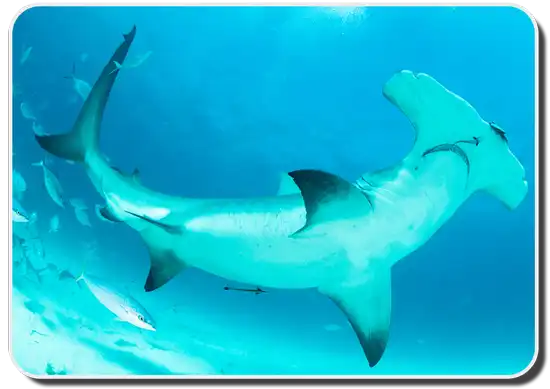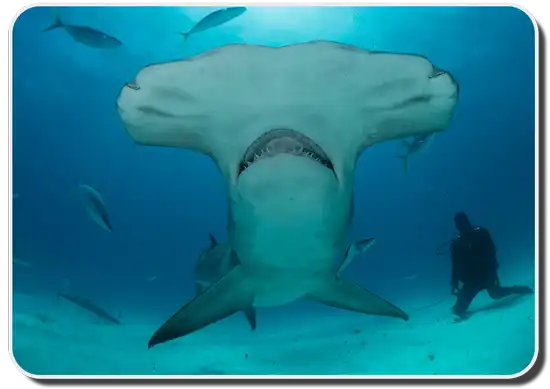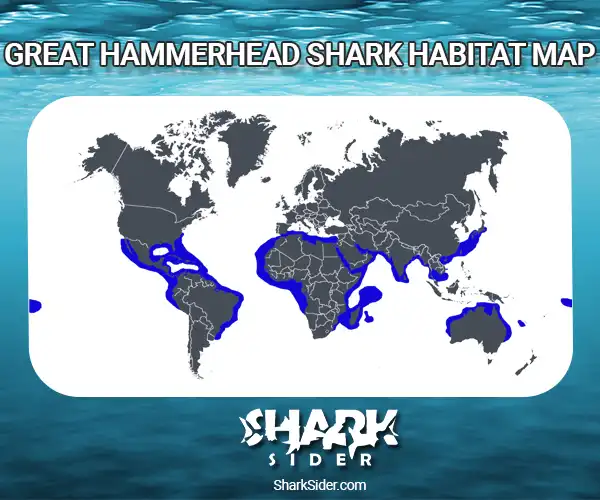The Great Hammerhead Shark is by far one of the most famous sharks around. Everyone knows this amazing creature exists, but here we’ll dive into some of the more interesting facts about one of the most amazing species of fish in the world.

Great Hammerhead Shark Scientific Classification |
|
| Kingdom | Animalia |
| Phylum | Chordata |
| Class | Chondrichthyes |
| Order | Carcharhiniformes |
| Family | Sphyrnidae |
| Genus | Sphyrna |
| Scientific Name | S. mokarran |
Physical Attributes
The most well known factor about them would undoubtedly have to deal with their namesake. These sharks have flat, T-shaped heads that make them stand out from other sharks. Many people are highly intrigued and curious about the shape and benefits of the Hammerhead Shark’s head. They are long and flat in order to aid in the catching of prey. The eyes of these sharks are wide-set, and this displacement enables the Great Hammerhead to have a wider, more enhanced visual range. In addition, their heads are covered in ampullae of lorenzini, thus giving the shark a better advantage when trying to find prey that may be hiding.
Size and Color
Now there are a few different types of hammerheads, but the Great Hammerhead is by far the largest of the nine species of this shark. In fact, these Hammerheads can grow up to a length of 20 feet (5.5 m), and they can weigh up to 1,000 pounds (450 kg)! The coloration of the Great Hammerhead can range from gray-brown to green on their dorsal sides, and off-white on their ventral sides, and their teeth are extremely jagged and triangular.
Diet
Luckily, we are completely aware of the feeding habits and diet of the Great Hammerhead Shark. These sharks enjoy the tastes of various animals such as other sharks, squids, crabs, jacks, herrings, tarpon, sardines, boxfish, toadfish, sea catfish, groupers, and of course their absolute favorite dish, rays. Great Hammerhead Sharks love sting rays, guitar fish, skates, cow nose rays, and eagle rays in particular. These sharks hunt for their creature of choice twice a day around dawn and dusk.
Purpose Of The Hammer Shaped Head
Sting rays are unique creatures because they are completely flat, and they have the innate ability to lie on the ocean floor and completely camouflage themselves. This animal just happens to be the Great Hammerhead’s favorite meal however, so unfortunately for the rays, the Hammerhead knows exactly how to capture them. The act of capturing sting rays is where the shark’s head comes in handy.

The skin of a shark is covered in dermal denticles (tooth like structures) and on the Great Hammerhead, there are ridges on the crowns of these denticles that help lead scented water to its nares (nostrils). Not only that, but the aforementioned ampullae of Lorenzini serves as an eletrosensor that can detect the stingray’s electrical pulse. All in all, the Great Hammerhead swims directly above the ocean floor and sways it’s flattened head from side to side in the same fashion one would a metal detector. You have to admit this process is pretty cool (if you’re not a stingray of course)!
Habitat
Great Hammerhead Sharks can be spotted very far off shore as well as near the shoreline. They often migrate in large groups during the summer in search of cooler waters. These sharks are usually in temperate or tropical waters, and they can survive in estuaries, sandy plains, kelp forests, coral reefs, rocky reefs, fresh waters, the open ocean, the deep sea, polar sea, and intertidal waters. Great Hammerheads get around easily, and they are distributed throughout the world in quite a few places. If you happen to be around the Japanese, Indian, Arabian, Amazonian, Madagascaran, Southeast Asian, Southeast Australian/ New Zealand, Northern Australian, Western Australian, West African, Eastern North Atlantic/ Mediterranean, Caribbean, Western North Atlantic, Chilean, South Pacific, or Tropical Eastern Pacific waters, you may just catch a glimpse of a Great Hammerhead Shark.
Great Hammerhead Shark Habitat Map

Reproduction and Offspring
These sharks fertilize their eggs in the same way that other sharks do. The male shark has a body part called claspers. These claspers are basically an extension of their pelvic fins, and they are responsible for fertilizing the females’ eggs through her cloaca. Great Hammerhead Sharks reproduce in a Viviparous nature. This means that the mother’s fertilized eggs hatch while still in her uterus, and when she is ready, she gives birth to live pups. The Great Hammerhead Shark’s gestation period typically lasts for 11 months, and during this time, the mother nourishes her young by placenta that is connected to an umbilical cord; this cord attaches to the pups between their pectoral fins. To further explain this process, the placenta transfers oxygen and nutrients that are available in the mother’s bloodstream to the pups, and the pups’ waste gets transferred back through the placenta for the mother to eradicate. Just in case all of this wasn’t fascinating enough, they can give birth to a litter that is anywhere from 13-56 pups!
Great Hammerhead Shark Pups
Once these pups are born, they are usually 20-28 in (50-70 cm) in length, and juvenile Great Hammerheads feed on small teleost (bony) fish and crabs. It is believed that the females reach maturity once they have reach 8-10 ft (2.5-3 m) in length, and the males are mature at 7-9 ft (2.2-2.7 m).
Human Interaction
Great Hammerhead Sharks are not particularly targets for commercial fishing, however they are often by catch victims. Humans treasure the fins of these sharks, but they also consume fresh, dried salted, fresh-frozen, and smoked meat that are taken from other parts of the Great Hammerhead Sharks’ bodies. In addition, the oil from the livers is used for vitamins, their carcasses are turned into fish meal, and their hides are used for leather. The fins are extremely valuable because of the love of shark fin soup.
